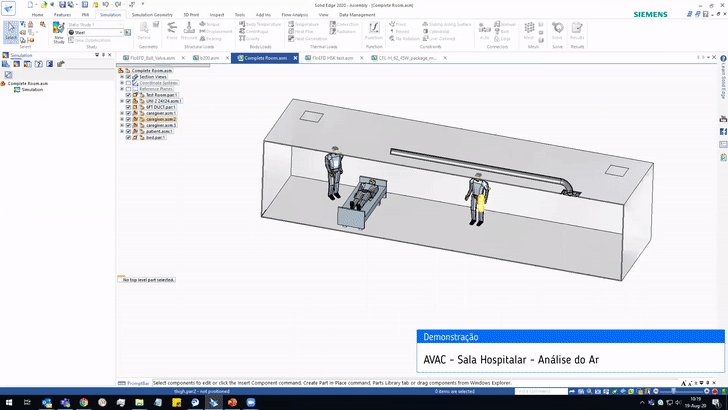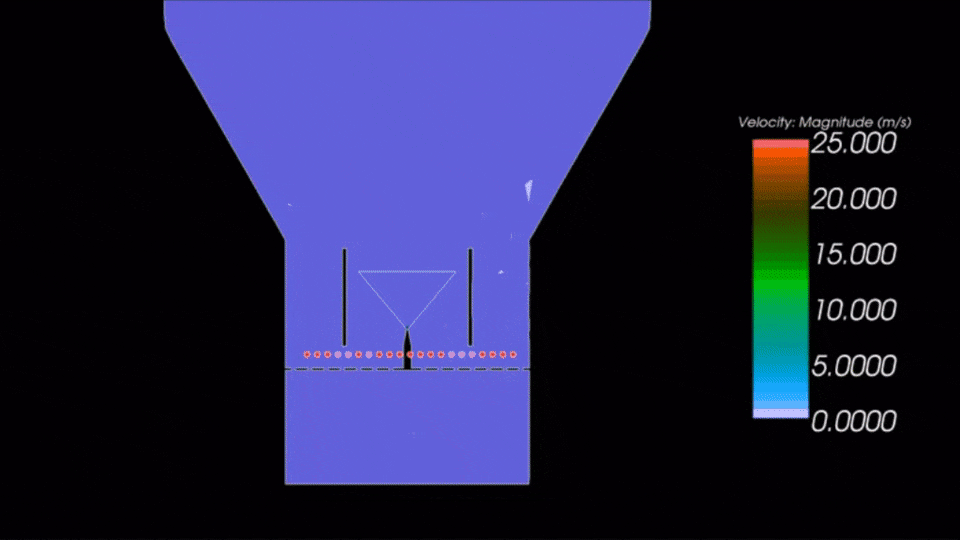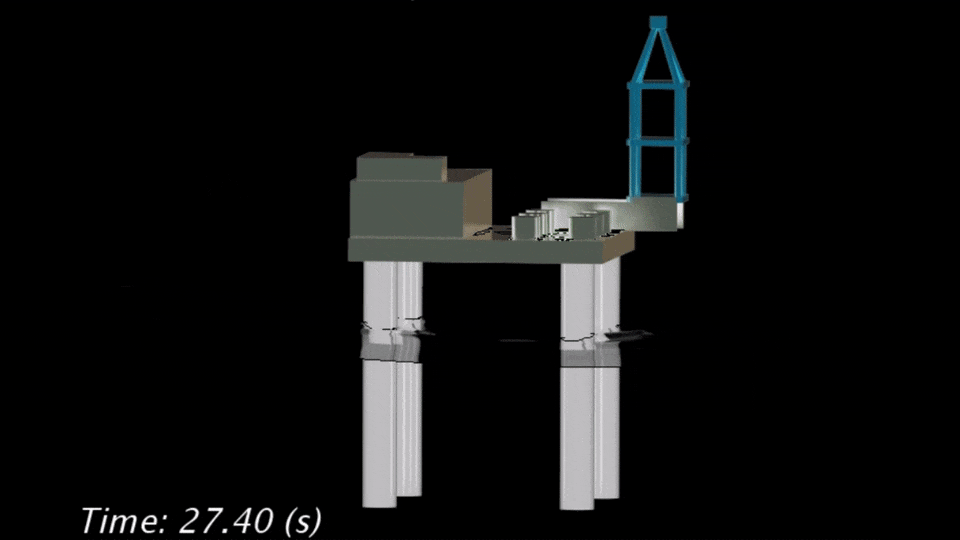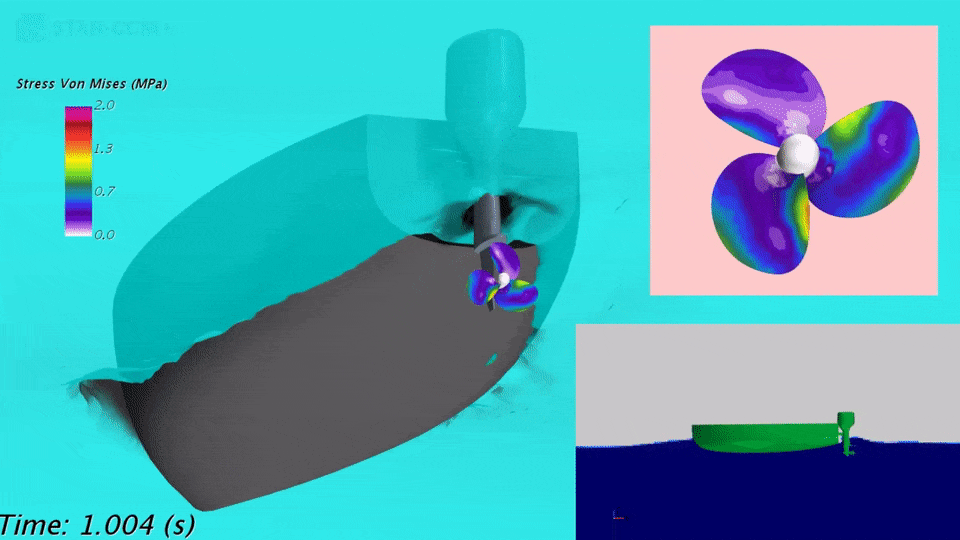
Computational Fluid Dynamics
Computational fluid dynamics, also known as CFD ( Computational Fluid Dynamics ), is a numerical simulation technique that allows studying the behavior of fluids under different conditions. This discipline can be used from the design of a space rocket to the design of a reactor in a chemical industry. That is, computational fluid dynamics is widely used in a variety of applications, such as the aeronautical industry, chemical processes, food processing, foundry, among others.
One of the main advantages of CFD is the possibility of observing, in three dimensions (3D), what happens inside industrial equipment, such as piping, heat exchangers, compressors, among others. This allows the identification of possible problems and the proposal of solutions to improve the performance of this equipment. In addition, CFD can also be used to identify critical points in systems and implement measures to mitigate these problems, thus ensuring the safety and efficiency of systems.








Transport Systems

Heat transfer
HVAC
Fluid Mixtures
Separation processes
Combustion
Particulate Systems
Flow in Structures
Naval systems
They assist in the design and dimensioning of fluid transport systems, such as pipes, ducts, distributors, blowers, compressors and pumps. It is possible to conduct studies with fluids of different physicochemical properties, in different operational conditions, such as pressure, flow and temperature. Through fluid dynamic simulation in these systems, it is possible to identify problems such as head loss, water hammer, obstruction points and fluid segregation, as well as propose solutions to mitigate these problems and reduce operating costs. In addition, this tool can be used to obtain performance data for equipment that is not found in the literature, such as operating curves for valves and pumps.
Using this computer simulation technique, it is possible to design, dimension, optimize and analyze heat transfer in industrial systems, such as heat exchangers, condensers, boilers, cooling towers, dryers and evaporators. It allows identifying problems such as hot spots, overheating zones, incrustation in heat exchangers, among others, and proposing solutions to improve energy efficiency. In addition, it is excellent for obtaining equipment performance data, such as the overall heat transfer coefficient, making it possible to integrate the fluid dynamic simulation with process simulators that need this input information.
They allow engineers and designers to analyze the behavior of air and coolant in refrigeration systems, such as air conditioning, freezers, refrigerators, cold rooms, among others. In this way, it is possible to identify problems such as undersizing, overheating and propose solutions to improve energy efficiency and the useful life of the system. Fluid dynamic analysis can also be used to study air flow in ventilation systems, such as building HVAC systems, factory ventilation systems, among others. This analysis makes it possible to identify problems such as areas of low circulation and air renewal and propose solutions to improve thermal comfort and air quality.
It is the best tool to analyze in detail how the mixing of fluids occurs, including heterogeneous and non-isothermal mixtures, allowing the analysis of the concentration distribution of the components and the temperature of the fluids, which is essential to guarantee safety and efficiency. of the processes. This type of analysis is very important in reaction systems, in thermal exchange systems, in mass transfer systems (such as absorption and distillation columns) among others, as it allows identifying problems such as component segregation, bubble formation, preferential paths and stagnation zones, phenomena that directly impact the efficiency of systems. Computational fluid dynamics is also a valuable tool to optimize the performance of these systems through parametric studies,
Excellent for optimizing the design of separation systems, such as filters, decanters, centrifuges, cyclones, distillation columns, among others. This makes it possible to identify problems such as poor particle distribution, sediment accumulation, flow resistance, low contact area between fluids, preferential paths, among others, and propose solutions to improve efficiency and avoid equipment oversizing. In addition, these tools can also be used to simulate and optimize complex mixture separation processes, such as the separation of volatile organic compounds, mixtures of gases and liquids, among others.
In the design and optimization of combustion systems, such as burners, furnaces, engines, among others, it is used to analyze in detail the behavior of the fuel fluid and air, as well as the thermal and thermochemical performance of the system. This makes it possible to identify problems such as excessive emission of pollutants, high temperature, poor heat distribution, among others, and propose solutions to improve energy efficiency and reduce environmental impact. In addition, it is possible to test several virtual prototypes and find, through parametric analysis, the best solution for the combustion process.
Several mathematical models are used to study the behavior of particulate systems, such as dust, grains, droplets, among others. This tool allows evaluating the transport of mass and energy in particulate systems, such as the movement of particles in a fluidized bed, the dispersion of particles in a fluid, the sedimentation of particles in equipment, among others. In addition, computational fluid dynamics studies can be coupled with another simulation technique, such as the Discrete Element Method (DEM), making the studies even more detailed. This type of system is found in several industries, such as oil refining, cement production, food processing, metallurgy, among others.
Structures such as buildings, bridges, telecommunications towers and oil platforms are subject to fluid flow. Through computer simulation of these structures, it is possible to assess how they behave under different conditions, such as strong winds, heavy rains and waves. In this way, it is possible to propose solutions to minimize the effects of these phenomena and guarantee the safety and stability of structures, preventing accidents and avoiding oversizing. In addition, this analysis can be used to evaluate the aerodynamic behavior of structures, identifying problems such as oscillations, vibrations and noise, and proposing solutions to mitigate these problems.
Marine systems are complex and require thorough analysis to ensure their safety, efficiency and durability. Computational fluid dynamics (CFD) is a valuable tool in this regard, as it allows simulating and analyzing the behavior of fluids in naval systems, such as ships, submarines and floating platforms. This makes it possible to evaluate the performance of propulsion, exhaust and maneuvering systems, identifying problems and proposing solutions to improve the safety, efficiency and durability of these systems. In addition, CFD tools can also be used to evaluate the flow behavior in different meteorological conditions, such as strong winds and waves, providing solutions to minimize the effects of these phenomena.
Simcenter STAR-CCM+ is highly respected 3D Computational Fluid Dynamics (CFD) software around the world, trusted by many established engineering companies in diverse industries. This tool is renowned for its ability to capture all of the physics that influence a product's performance over its lifetime of operation. It has advanced mathematical methods and sophisticated mathematical models, including multiphase and interface models, making it a powerful tool to explore and optimize the design of products involving highly complex phenomena.
From research and development institutes to equipment and process design companies, engineers use Simcenter STAR-CCM+ as their primary tool, as it is a valuable tool for improving product design and development processes, enabling engineers to perform accurate simulations. and reliable tools that cover a wide range of engineering disciplines. In addition, design exploration and optimization tools, along with automated mesh generation, help make the design process more efficient and make better decisions. The Simcenter STAR-CCM+ integrated environment also provides a complete solution, allowing engineers to work more efficiently and faster. In addition, it allows integration with other engineering tools, such as FEA and DEM,
FloEFD is 3D computational fluid dynamics (CFD) software that provides a quick and easy way to perform flow and heat transfer simulations in equipment. It integrates directly with leading design software such as SolidWorks, AutoCAD and Creo, allowing engineers to perform CFD simulations directly within the CAD environment. One of the main advantages of this tool is that it is not necessary to be an expert in computational fluid dynamics to use it, as it is designed to be easy to use and offers an intuitive interface.
It is the ideal tool for those seeking solution speed, as it uses efficient solution methods in terms of processing time. Its integration with design tools and Cartesian-type meshing allows the designer to test different scenarios and design alternatives quickly and accurately, making it a valuable tool for designers who want to integrate CFD simulation with their CAD designs.